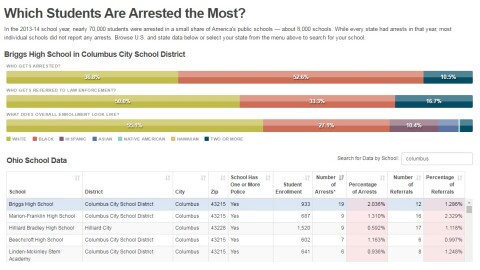Tyrus Jennings, 18, says he does his best to stay away from trouble. Several years ago, though, trouble found him.
Someone fired shots close to where he was standing outside, and a stray bullet went through his left leg. It could easily have been worse.
Columbus saw 106 murders last year, with many of the victims and offenders being young people.
That’s because, as a study from Ohio State University found, the social networks among friends help spread violence like a contagious disease.
Jennings attends high school and works at a restaurant. But he said he’s seen some of his friends go down the wrong path.
“One of my close friends got murdered a couple of summers ago,” Jennings said. “And the friends I was hanging with, they wasn’t doing what I was doing, they wasn’t trying to be as positive as I was trying to be. So I knew what I had to do was cut myself away.”
Ohio State researcher Brad Bushman says friend connections can play a strong influence for young people to become violent.
“What’s unique about our study is that it shows the influence spreads beyond one’s friend,” said Bushman.
Bushman, in the study he co-authored, examined a sample of more than 6,000 students, ages 12-18 from 142 high schools across the U.S. The students answered in-depth questions for a national health violence, and each person listed five male friends and five female friends in their social circle.
Through the year, students reported the number of times they were involved in a serious physical fight, hurt someone badly or pulled a weapon on someone.
“We found that participants were 140 percent more likely to pull a weapon on someone if their friend had also pulled a weapon on someone,” Bushman said. “And that spread three degrees – to their friend’s friend’s friend.”
(A previous Ohio State-sponsored study Bushman co-authored in 2012, on the connections between first-person shooter video games, marksmanship and aggression, was recently retracted for questionable research.)

Bushman says the study also found adolescents were up to 183 percent more likely to carry out some acts of violence if one of their friends committed the same act. The results suggest violence spreads up to four degrees of separation, from one person to a friend, to the friend’s friend and two more friends beyond.
And, it’s important to note, the effects of a friend connection were stronger for males.
“If you view violence like a contagious disease, that can spread from person to person, then, well, you treat it the same way you would treat any other contagious disease," Bushman says.
Pastor LaMarr of Family Missionary Baptist Church disagrees with the findings. He doesn’t see violence as a disease at all.
“You’ve got 10 percent of the people doing all the problems and it gives the wrong picture," LaMarr says.
La Marr frequently walks around Columbus’ south side neighborhood to check out what’s going on. He says he knows what causes makes the city dangerous.
“Boarded houses don’t attract violence," LaMarr says. "What attracts violence is when you have carry-outs that are not properly monitored - you know, carry-outs that come and they sell cigarettes and sell liquor and all those things."

Family Missionary Baptist Church sponsors several programs for young people who want to not just hang out but also be productive. Tyrus Jennings is one of his
“There is violence, but what is the root cause?” LaMarr says. “See, if we really want to address the fruit, we’ve got to connect to the root. So what is the cause of all the violence? It is economically driven.”
Society needs to prevent people from exposure to violence in the first place, Bushman says.
But finding answers to why violence spreads among social networks will require more study. Bushman wants to know how social media like Facebook, Twitter and Instagram play a role.
There is a bright spot, however. Social networks, Bushman’s research found, can also be a force to spread positive behavior among friend connections, too.



